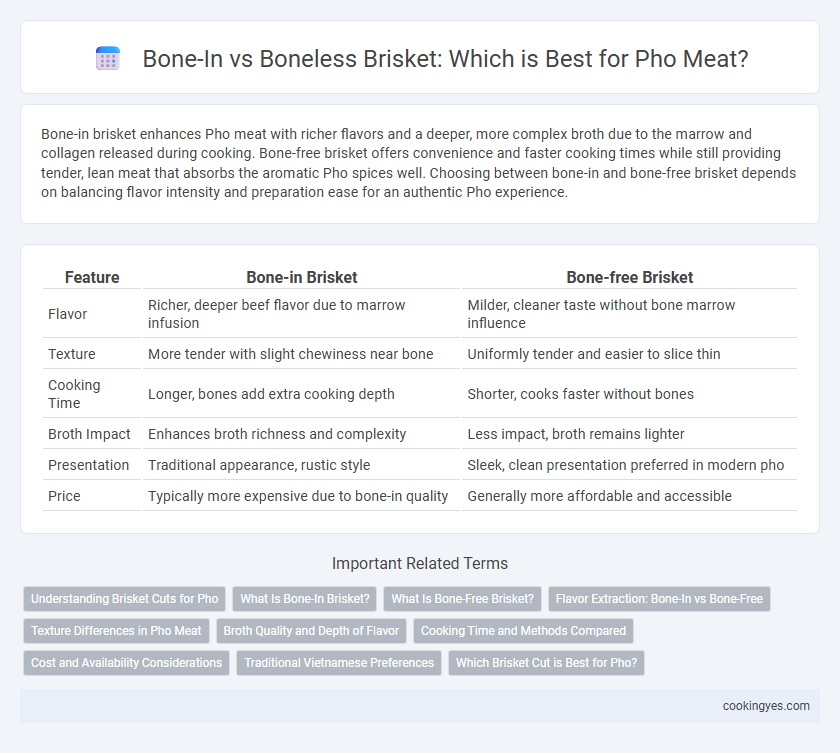Bone-in brisket enhances Pho meat with richer flavors and a deeper, more complex broth due to the marrow and collagen released during cooking. Bone-free brisket offers convenience and faster cooking times while still providing tender, lean meat that absorbs the aromatic Pho spices well. Choosing between bone-in and bone-free brisket depends on balancing flavor intensity and preparation ease for an authentic Pho experience.
Table of Comparison
| Feature | Bone-in Brisket | Bone-free Brisket |
|---|---|---|
| Flavor | Richer, deeper beef flavor due to marrow infusion | Milder, cleaner taste without bone marrow influence |
| Texture | More tender with slight chewiness near bone | Uniformly tender and easier to slice thin |
| Cooking Time | Longer, bones add extra cooking depth | Shorter, cooks faster without bones |
| Broth Impact | Enhances broth richness and complexity | Less impact, broth remains lighter |
| Presentation | Traditional appearance, rustic style | Sleek, clean presentation preferred in modern pho |
| Price | Typically more expensive due to bone-in quality | Generally more affordable and accessible |
Understanding Brisket Cuts for Pho
Bone-in brisket offers richer, deeper flavors for Pho due to the marrow and collagen surrounding the bone, which enrich the broth with gelatin and umami compounds. Bone-free brisket provides a leaner, more uniform texture, making it easier to slice thinly and cook evenly without the risk of bone fragments. Understanding the difference helps achieve the desired balance between broth richness and meat tenderness in traditional Pho preparation.
What Is Bone-In Brisket?
Bone-in brisket in pho consists of a cut of beef brisket with the bone still attached, adding deeper richness and complexity to the broth through marrow infusion. This cut enhances the soup's flavor profile by releasing gelatin and fat from the bone, creating a silky texture and intense savory aroma. Compared to bone-free brisket, bone-in brisket offers a more robust and traditional pho experience favored by many enthusiasts for its authentic taste.
What Is Bone-Free Brisket?
Bone-free brisket in Pho is a tender cut of beef from the lower chest without the attached bone, offering a cleaner texture and easier slicing for the broth. It cooks faster than bone-in brisket, providing a more uniform meat consistency without the rich marrow flavor extracted from bones. This cut is favored for a leaner, more delicate pho experience, ideal for those seeking pure beef taste without the heavier, gelatinous qualities that bones contribute.
Flavor Extraction: Bone-In vs Bone-Free
Bone-in brisket imparts a richer, deeper flavor to pho broth due to the marrow and collagen released during slow simmering, enhancing the broth's umami and complexity. Bone-free brisket offers a cleaner, leaner taste but lacks the gelatinous texture and savory depth provided by bones. For optimal flavor extraction, bone-in brisket is preferred to achieve a robust and aromatic pho broth.
Texture Differences in Pho Meat
Bone-in brisket in pho offers a richer, more gelatinous texture due to marrow and connective tissues that dissolve during cooking, enhancing mouthfeel and broth depth. Bone-free brisket, by contrast, provides a firmer, leaner bite with a cleaner taste, favored for its ease of slicing and consistency. The choice directly influences pho's textural complexity, where bone-in brisket contributes to a softer, more succulent experience and bone-free brisket delivers a slightly denser, meatier chew.
Broth Quality and Depth of Flavor
Bone-in brisket enhances pho broth quality by releasing collagen and marrow during simmering, resulting in a richer, more gelatinous texture and complex umami depth. Bone-free brisket cooks faster and offers a leaner texture but lacks the savory richness imparted by bones, leading to a broth with less body and layered flavor. For authentic pho, the extended extraction from bone-in cuts is essential to achieve a deeply flavorful and aromatic broth.
Cooking Time and Methods Compared
Bone-in brisket for Pho requires longer cooking times, typically simmered for 3 to 4 hours to extract rich collagen and deepen flavor complexity. Bone-free brisket cooks faster, usually around 1.5 to 2.5 hours, offering a leaner texture but less gelatinous broth. Slow simmering enhances tenderness in both cuts, while bone-in brisket benefits from the marrow's contribution to a fuller, more savory Pho broth.
Cost and Availability Considerations
Bone-in brisket for pho typically costs less due to the presence of the bone, offering richer flavor and collagen that enhances broth quality, making it a cost-effective choice for authentic pho preparation. Bone-free brisket is more readily available in many markets and requires less preparation time, appealing to restaurants prioritizing convenience and consistency, though it usually comes at a higher price point. Choosing between the two depends on balancing budget constraints with desired flavor intensity and ingredient accessibility in pho meat selection.
Traditional Vietnamese Preferences
Traditional Vietnamese Pho recipes often favor bone-in brisket for its richer, more flavorful broth, as the bones release essential collagen and marrow during long simmering. Bone-in brisket contributes to the dish's authentic depth and umami, aligning with centuries-old culinary practices in Vietnam. While bone-free brisket offers convenience and ease of slicing, it lacks the full-bodied taste profile that defines classic Pho broth.
Which Brisket Cut is Best for Pho?
Bone-in brisket is preferred for Pho due to its rich flavor and collagen that melts into the broth, enhancing depth and texture. Bone-free brisket offers convenience and tenderness but lacks the savory complexity that slow-simmered bones provide. Choosing bone-in brisket ensures a more authentic, aromatic Pho experience packed with umami.
Bone-in brisket vs bone-free brisket for Pho meat Infographic

 cookingyes.com
cookingyes.com